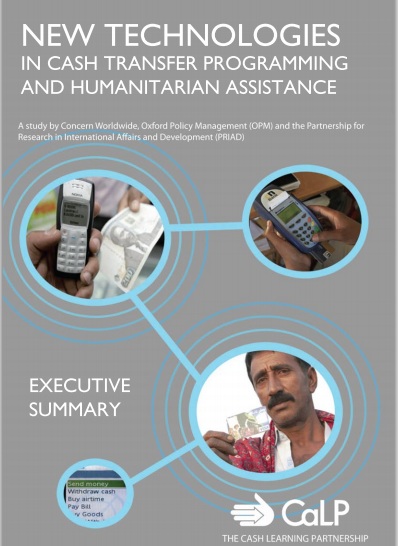Over the last two years, we have worked to raise awareness of the potential of SMS, and FrontlineSMS, as a sustainable, capacity-building tool in humanitarian response. We have documented how our software is being used to manage and coordinate aid responses by a wide variety of organizations - including OCHA, Action Aid and Infoasaid, European Disaster Volunteers, Popular Engagement Policy Lab – and in a range of contexts - including Kenya, Pakistan and Haiti. We have also produced a tailored checklist on what to consider when planning use of mobile technology for humanitarian response. All of this content is representative of a more general trend; that of a growing number of humanitarian organizations keen to engage with how ICTs can help support their work.

In March 2012, we participated in two events in London which demonstrated this increasing interest. The first, a two-day Media and Tech Fair hosted by the Communicating with Disaster Affected Communities Network (CDAC), showcased technologists and implementers from all over the world, sharing with an audience of CEOs and decision-makers how their solutions and pilots have begun to change the way they engage and communicate with the people they work to help. The second day of this event featured practical workshops and scenario-based discussions, intended to help people to think through how they could put these tools and approaches into practice on the ground.
The second was an afternoon event - co-hosted by the Overseas Development Institute (ODI), Active Learning Network for Accountability and Performance in Humanitarian Action (ALNAP) and the Cash and Learning Partnership (CaLP) - launched an excellent report written by the team at Concern UK: New Technologies in Cash Transfer Programming and Humanitarian Assistance. Our Director of Operations, Laura Walker Hudson, participated in a panel discussion reflecting on the themes raised in the report, and we were pleased to have had the opportunity to have contributed to Concern’s research.
The report takes an in-depth look at the current use of new technology in humanitarian cash and voucher programming, and the broader implications this has for humanitarian practice. In addition to some positive cross-cutting themes – such as the improved accountability and cost-effectiveness which can result from successful use of technology in humanitarian work – the report also contains advice on mitigating some of the challenges that still obstruct wider implementation. The result is a thoughtful and broad-based survey of the opportunities and challenges facing humanitarian agencies in selecting and rolling out technological tools - reflections which are valuable across all sectors, not just humanitarian aid, for their honesty in assessing institutional barriers to change and innovation. We will examine some of these issues in a future post, and consider their relevance for anyone trying to mobilize information management and communications.
For now, a few broad themes recurred in both events:
- Disaster affected populations are already utilizing ICTs on the ground, and the globalized nature of news and volunteerism means that groups like the Standby Taskforce are pitching in to help manage and process data. If agencies fail to acknowledge progress made by others, they will be left behind.
- Erik Hersman, one of the founders of Ushahidi, reiterated a core value we share in his keynote summary of the first day of the CDAC event: technology is only a small part of what needs to be considered in planning discussions; the context, the program design, training and sustainability, and most importantly, listening to the people the project seeks to help, are a larger part of the effort and critical to success.
- The critical importance of cross-sectoral and inter-agency collaboration recurred again and again, at both events. To avoid duplication of effort, conflicting data standards, wasted resources and crowded information marketplaces in emergencies, key stakeholders must work together, and seek to understand others’ perspectives in a rapidly evolving area. Working in a consortium, or creating open-source tools available to everyone, could potentially speed up development of useful platforms and improved learning about what works and what doesn’t. Collaborating effectively with the private sector and with technologists could far more effectively harness additional resources and intellectual capital, and a coordinated ask of major players, such as the GSMA, is crucial - but can feel impossible to secure.
All in all, the humanitarian sector has a long way to go, particularly at head office level, but our team was left with a sense that there are a growing number of humanitarians who are taking an agile, open and open-minded approach to trialling new tools and sharing their findings with others. Yet it is at field and regional level that the real innovation is happening, away from the overlapping priorities and initiative overload that characterizes the global management hubs in New York, London and Geneva. As ICTs in humanitarian aid become more commonplace and begin to integrate more fully into the standard agency toolkit, agencies, technologists and the private sector must continue to build relationships and exchange information in order to build sustainable, coordinated, and appropriate use of technology in humanitarian response.
Following both of these events, valuable resources have been made available online:
CDAC event:
- All videos, photos, case studies and resources from the day can now be found online
- Case studies featuring FrontlineSMS use include:
- Using FrontlineSMS for a complaints and response mechanism after the Pakistan floods
- Infoasaid and Action Aid partnership and communications initiative in Kenya
- International Organization for Migration - Flood Affected Citizens Damage Compensation Program (whose use of FrontlineSMS we covered on our blog here)
ODI and CaLP event:
- New Technologies and Cash Transfer Programming in Humanitarian Assitance Report
- Videos from the panel discussion at this event, including our very own Laura Walker Hudson


